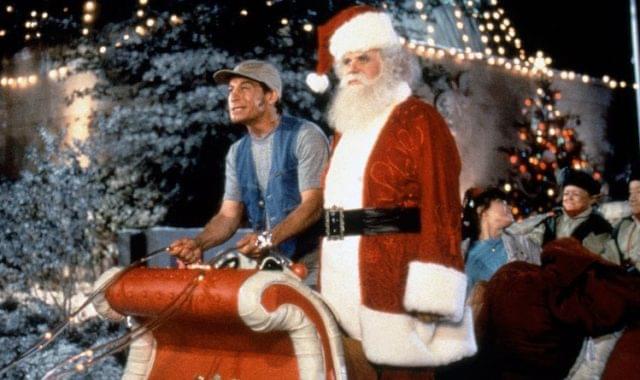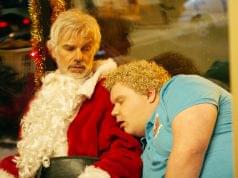
As a comic actor, Jim Varney’s only major flaw was that he wasn’t funny. He had energy to spare, he could make silly faces, and he was really good at convincing viewers that he was a clueless redneck who said “KnowwhatImean?” a lot. He apparently managed to make some of those viewers laugh, too, despite the aforementioned shortcoming of not being funny. Not everyone can overcome odds like that. For example, Carson Daly isn’t funny, and sure enough, he’s never made anyone laugh.
Varney’s lasting contribution to the world of cinema is his series of “Ernest” films, which include “Ernest Goes to Camp,” “Ernest Goes to Jail,” “Ernest Goes to Darfur,” “Ernest Goes to the Free Clinic to Have Someone Look at This Rash,” and, near the end of his career, “Ernest Goes on Welfare.” These are by all accounts lighthearted, family-friendly comedies unfettered by quality or innovation.
That is certainly true of “Ernest Saves Christmas,” Varney’s 1988 foray into the genre of un-amusing but harmless holiday films. Like most of these syrupy concoctions, “Ernest Saves Christmas” is meant to remind viewers of the true meaning of the season, which has something to do with snow, Santa Claus, and capitalism. (Ernest is briefly shown to have a “Put the Christ Back in Christmas” bumper sticker; ironically, that’s the only time Jesus is referred to in the entire film.)
Ernest is a Mr. Magoo type who causes destruction everywhere he goes but fails to realize it. We are supposed to laugh at the mayhem he provokes, despite the thousands of dollars in property damage and Ernest’s utter lack of remorse for (or even awareness of) his crimes. One of this film’s centerpieces has Ernest showing up at his unseen friend Vern’s house and completely annihilating his living room in an attempt to set up a Christmas tree. Throughout the entire Ernest canon of films and TV commercials, Vern is frequently the victim of Ernest’s friendship, and it’s wise that we never see him. If we did, we would surely see the despair in his eyes, the hopelessness in his soul. The film doesn’t show us that later, on Christmas Day, Vern put a gun in his mouth and pulled the trigger.
But ho ho ho! There are merrier things to discuss! The plot of “Ernest Saves Christmas” concerns Santa Claus (Douglas Seale) arriving in Orlando on Dec. 23 in order to anoint his successor in the Santa Claus business. As would later be more fully explored in Tim Allen’s scholarly “Santa Clause” trilogy, “Santa Claus” is not really a name but a title. The current St. Nick has been at it for 150 years, and it’s time for him to retire. He’s been forgetting some of the kids’ names, he frequently drives the sleigh for miles at a time with the blinker on, and his struggles with incontinence have led the elves to start calling him “Kris Tinkle” behind his back.
The replacement he has chosen is a children’s TV show host named Joe (Oliver Clark). Santa, who is sometimes cagey about his identity and sometimes very forthright, depending on the needs of the plot, shows up at the children’s museum where Joe is making an appearance, then is hauled away by the police for being a crazy old man before he gets a chance to tell Joe his plans. Somewhere in all this, Santa misplaces his enchanted bag of toys, leading him to declare, “I lost my sack!” Much subsequent dialogue centers around the need to reunite Santa with his magic sack. I submit that, while unintended, the constant references to Santa’s sack are the most entertaining element of the film, particularly if you are a seventh-grade boy.
So how is Ernest involved in all this? Well, he was the cab driver who picked Santa up at the airport, and he’s now in possession of the aforementioned sack. He also has with him, for some reason, a teenage runaway named Harmony Starr (Noelle Parker), which obviously is not her real name but the name of a stripper she once knew, or perhaps the stripper she one day hopes to be. Harmony is street-wise and cynical and has forgotten the true meaning of Santaclausmas. She and Ernest go to the county lockup, where Santa’s being held, and get him out by pretending to be representatives from the governor’s office on a surprise inspection. For reasons the movie doesn’t deign to share with us, this is apparently easier than just posting his bail. Then again, maybe no bail was set, considering he was neither charged with nor guilty of any crime.
At any rate, he’s out, and time’s a-wastin’! He has to find Joe and convince him to take over the Santa duties before 7 p.m. on Christmas Eve. If Joe doesn’t accept prior to that deadline, then, according to Santa, “the magic of Christmas, the joys, the feelings, will be gone forever.” Just like that! Evidently a lapse in the succession of Santa Clauses will result in Jesus never having been born!
You would think that given the dire situation at hand, Santa would have started working on all this a little sooner than the day before. I’m just sayin’.
Everything turns out OK, obviously; we’ve had 20 Christmases since the film came out, and none of them suffered from a lack of magic, joys, or feelings. Christmas has indeed been saved, though I note that despite the film’s title, Ernest had very little to do with it. And that’s just as well. I’m not sure I’d have much faith in a holiday so flimsy that it needed rescuing by an ignorant hillbilly anyway.
— Film.com





